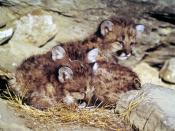On April 23, 1994, as Barbara Schoener was jogging in the Sierra foothills of California, a mountain lion pounced on her from behind. After an apparent struggle with her attacker, Schoener was killed by bites to her neck and head (Rychnovsky 39). In 1996, because of Schoener's death and other highly publicized attacks, California politicians presented voters with Proposition 197, which contained provisions repealing much of a 1990 law enacted to protect the lions. The 1990 law outlawed sport hunting of mountain lions and even prevented the Department of Fish and Game from thinning the lion population.
Proposition 197 was rejected by a large margin, probably because the debate turned into a struggle between hunting and anti-hunting factions. When California politicians revisit the mountain lion question, they should frame the issue in a new way. A future proposition should retain the ban on sport hunting but allow the Department of Fish and Game to control the population.
Wildlife management would reduce the number of lion attacks on humans and in the end would also protect the lions.
The once-endangered mountain lion
To early Native Americans, mountain lions--also known as cougars, pumas, and panthers--were objects of reverence. The European colonists, however, did not share the Native American view. They conducted what Ted Williams calls an "all-out war on the species" (29). The lions were eliminated from the eastern United States except for a small population that remains in the Florida Everglades.
The lions lingered on in the West, but in smaller and smaller numbers. At least 66,665 lions were killed between 1907 and 1978 in Canada and the United States (Hansen 58). As late as 1969, the country's leading authority on the big cat, Maurice Hornocker, estimated the United States population as fewer than 6,500 and probably dropping (Williams 30).
Resurgence of the mountain lion
In western states today, the mountain lion is no longer in danger of extinction. In fact, over the past thirty years, the population has rebounded dramatically. In California, fish and game officials estimate that since 1972 lion numbers have increased from 2,400 to at least 6,000 ("Lion" A21).
Similar increases are occurring outside of California. For instance, for nearly fifty years, mountain lions had virtually disappeared from Yellowstone National Park, but today lion sightings are increasingly common. In 1992, Hornocker estimated that at least eighteen adults were living in the park (59). In the United States as a whole, some biologists estimate that there are as many as 50,000 mountain lions, a dramatic increase over the 1969 estimate of 6,500 (Williams 30).
For the millions of Americans interested in the preservation of animal species, this is good news, but unfortunately, the increase has led to a number of violent encounters between human and lion.
Increasing attacks on humans
There is no doubt that more and more humans are being attacked. A glance at figure 1, a graph of statistics compiled by mountain lion researcher Paul Beier, confirms just how dramatically the attacks have increased since the beginning of the century. Ray Rychnovsky reports that thirteen people have been killed and lions have mauled another fifty-seven since 1890. "What's most startling," writes Rychnovsky, "is that nearly three-quarters of the attacks [. . .] have taken place in the last twenty-five years" (41).
Particularly frightening are the attacks on children. Kevin Hansen points out that children have been "more vulnerable than adults, making up 64 percent of the victims" (69). This is not surprising, since children, being small and active, resemble the lion's natural prey. Lion authority John Seidensticker reports that when he worked for the National Zoo in Washington, DC, he regularly observed cats stalking children who passed by the lion cages (120).
Since 1986, four children have been attacked in California ("Mountain" 7). One of these attacks was serious enough to prompt officials to place Casper's Wilderness Park off-limits to children (Tran B8). In July 1997 alone, two attacks on children, one fatal, occurred in different national parks in Colorado (McGhee A1).
In California, the state where the lion is most fully protected, 1994 was a particularly bad year. Los Angeles Times writer Tony Perry reports that two women were killed by lions in 1994 and that the year brought a dramatic increase in mountain lion sightings, "many in suburban and urban areas where the animal had previously not been spotted" (B4). With two killings in one year and an increasing number of sightings, it is not surprising that California politicians responded with Proposition 197, aimed at repealing the ban on hunting the lions.
The 1996 California referendum
The debate over Proposition 197 was inflamed by campaigns of misinformation on both sides of the issue. The pro faction included the National Rifle Association (NRA), the Safari Club, and Gun Owners of California. On the other side were animal rights groups such as the Sierra Club, the Fund for Animals, and the Mountain Lion Foundation.
The proposition itself, introduced by Republican Tim Leslie, is laced with legalese and deceptive phrasing. For example, in a provision aimed at amending section 4801 of the Fish and Game Code, the word hunters does not appear, though the legalistic term designee clearly includes hunters:
The department may remove or take, or authorize its designee, including, but not limited to, an appropriate governmental agency with public safety responsibility, an appropriate governmental agency with wildlife management responsibility, or an owner of land, to remove or take, one or more mountain lions that are perceived to be an imminent threat to public health or safety or livestock anywhere in the state except within the state park system. ("Proposition" sec. 5)
The proposition's euphemistic language, such as remove or take, was echoed by the hunting factions, who spoke much about "controlling" the lion population, avoiding such words as hunt and shoot.
Supporters of Proposition 197 were not above exaggerating the dangers posed by mountain lions, preferring lurid accounts of mauling and killings to solid statistics. For example, writing on the Internet in an attempt to sway voters, Terrence M. Eagan, Wayne Long, and Steven Arroyo appeal to human fears of being eaten: "Two small children woke up one morning without a mother because a lion ate her." To underscore the point, they describe a grisly discovery: "A lion preying upon neighborhood pets was found with parts of five different puppies in its stomach."
Whereas the pro-hunting groups used deceptive language and exaggerated the dangers posed by lions, the pro-lion groups invoked inflammatory language and ignored
the danger. A Web page written by a coalition of wildlife preservationists is typical. Calling Proposition 197 "a special interest trophy hunting measure," the coalition claims that the Gun Owners of California, the NRA, and the Safari Club "rammed" the proposition onto the ballot while "hiding behind a disingenuous concern for public safety." Asserting that the mountain lion poses a minimal threat to humans, the coalition accuses the Department of Fish and Game of "creating a climate of fear" so that the public will choose to reinstate lion hunting (California Wildlife Protection Coalition). While it is true that human encounters with mountain lions are rare, some pro-lion publications come close to ridiculing Californians who fear that lion attacks on humans and pets will continue to accelerate unless something is done.
Population control: A reasonable solution
Without population control, the number of attacks on Californians will almost certainly continue to rise, and the lions may become even bolder. As lion authority John Seidensticker remarks, "The boldness displayed by mountain lions just doesn't square with the shy, retiring behavior familiar to those of us who have studied these animals" (177). He surmises that the lions have become emboldened because they no longer have to contend with wolves and grizzly bears, which dominated them in the past. The only conceivable predator to reinstall that fear is the human.
Sadly, the only sure way to reduce lion attacks on humans is to thin the population. One basic approach to thinning is sport hunting, which is still legal, though restricted in various ways, in every western state except California. A second approach involves state directed wildlife management, usually the hiring of professional hunters to shoot or trap the lions.
Sport hunting is a poor option--and not just because it is unpopular with Californians. First, it is difficult to control sport hunting. For instance, a number of western states have restrictions on killing a female lion with kittens, but sport hunters are rarely knowledgeable enough to tell whether a lion has kittens. Second, because some sport hunters are poor shots, they wound but do not kill the lions, causing needless suffering. Finally, certain hunting practices are anything but sport. There is a growing business in professionally led cougar hunts, as a number of ads on the World Wide Web attest. One practice is to tree a lion with radio-equipped dogs and then place a phone call to the client to come and shoot the lion. In some cases, the lion may be treed for two or more days before the client arrives to bag his trophy. Such practices are so offensive that even the California Park Rangers Association opposed Proposition 197. As a spokesperson explained, "We support managing the lions. But they shouldn't be stuck on the wall in a den" (qtd. in Perry B4).
We should entrust the thinning of the lion population to wildlife specialists guided by science, not to hunters seeking adventure or to safari clubs looking for profits. Unlike hunters, scientific wildlife managers have the long-term interests of the mountain lion at heart. An uncontrolled population leads to an ecological imbalance, with more and more lions competing for territory and a diminishing food supply. The highly territorial lions will fight to the death to defend their hunting grounds; and because the mother lion ultimately ejects her offspring from her own territory, young lions face an uncertain future. Stephanie Cruickshank, a spokesperson for California Lion Awareness (CLAW), explains, "The overrun of lions is biologically unsound and unfair to the lions, especially those forced to survive in marginal or clearly unnatural urban settings" (qtd. in Robinson 35).
In conclusion, wildlife management would benefit both Californians and the California lions. Although some have argued that California needs fewer people, not fewer lions, humans do have an obligation to protect themselves and their children, and the fears of people in lion country are real. As for the lions, they need to thrive in a natural habitat with an adequate food supply. "We simply cannot let nature take its course," writes Terry Mansfield of the Department of Fish and Game (qtd. in Perry B4). In fact, not to take action in California is as illogical as reintroducing the lions to Central Park and Boston Common, places they once also roamed.
Works Cited
California Wildlife Protection Coalition. California Mountain Lion Page. 27 Mar. 1996.
Sierra Club. 24 Mar. 1999 .
Eagan, Terrence M., Wayne Long, and Steven Arroyo. "Rebuttal to Argument against Proposition 197." 1996 California Primary Election Server. 1996. California Secretary of State. 24 Mar. 1999 .
Hansen, Kevin. Cougar: The American Lion. Flagstaff: Northland, 1992.
Hornocker, Maurice G. "Learning to Live with Lions." National Geographic July 1992: 37 65.
"Lion Attacks Prompt State to Respond." New York Times 18 Oct. 1995, late ed.: A21.
McPhee, Mike. "Danger Grows as Lions Lose Fear." Denver Post 19 July 1997. 2nd ed.: A1.
"Mountain Lion Attacks on Humans." Outdoor California. 21 Mar. 1996. State of California. Dept. of Fish and Game. 24 Mar. 1999 .
Perry, Tony. "Big Cat Fight." Los Angeles Times 8 Mar. 1996, home ed.: B1+. "Proposition 197: Text of Proposed Law." 1996 California
Primary Election Server. 1996. California Secretary of State. 24 Mar. 1999 .
Robinson, Jerome B. "Cat in the Ballot Box." Field and Stream Mar. 1996: 30-35.
Rychnovsky, Ray. "Clawing into Controversy." Outdoor Life Jan. 1995: 38-42.

![[California delegates cheering on stagecoach at the 1912 Republican National Convention held at the Chicago Coliseum, Chicago, Illinois, June 18-22, 1912] (LOC)](https://s.writework.com/uploads/9/94858/california-delegates-cheering-stagecoach-1912-republican-na-thumb.jpg)
